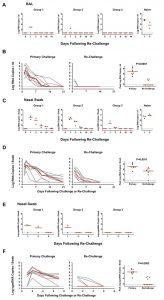
Viral loads following SARS-CoV-2 rechallenge in rhesus macaques.
On day 35 following initial infection (Fig. 1), rhesus macaques were rechallenged with SARS-CoV-2by the intranasal and intratracheal route with 1.1 × 106 PFU (Group 1; N = 3), 1.1 × 105 PFU (Group 2; N = 3), or 1.1 × 104 PFU (Group 3; N = 3). Three naïve animals were included as a positive control in the rechallenge experiment. (A) Log10 viral RNA copies/ml (limit 50 copies/ml) were assessed in bronchoalveolar lavage (BAL) at multiple timepoints following rechallenge. One of the naïve animals could not be lavaged. (B) Comparison of viral RNA in BAL following primary challenge and rechallenge. (C and E) Log10 viral RNA copies/ml (C) and log10 sgmRNA copies/swab (limit 50 copies/ml) (E) were assessed in nasal swabs (NS) at multiple timepoints following rechallenge. (D and F) Comparison of viral RNA (D) and sgmRNA (F) in NS following primary challenge and rechallenge. Red horizontal bars reflect median viral loads. P-values reflect two-sided Mann-Whitney tests. (Source: Chandrashekar et al., 2020)
With an impending second wave of SARS-CoV-2 infections predicted, one important question is whether a person infected once can develop enough durable protective immunity to prevent re-infection when exposed again. In a recent edition of Science, a rhesus macaque model of SARS-CoV-2 infection was developed, where “high viral loads in the upper and lower respiratory tract, humoral and cellular immune responses, and pathologic evidence of viral pneumonia” was observed. After clearance of the initial infection in all nine animals used, they were re-challenged with SARS-CoV-2 and there was a 5 log10 reduction in viral loads in bronchoalveolar lavage and nasal mucosa. However, the authors conclude: “Given the near-complete protection in all animals following SARS-CoV-2 re-challenge, we were unable to determine immune correlates of protection in this study.” This was despite the monkeys making robust humoral and cellular responses. It is tempting to regard the rapid neutralizing antibody responses, along with T cell immunity, as mediators of protection from re-infection. However, this has yet to be shown. The authors conclude: “These data raise the possibility that immunologic approaches to the prevention and treatment of SARS-CoV-2 infection may in fact be possible.”
Journal Article: Chandrashekar et al., 2020. SARS-CoV-2 infection protects against rechallenge in rhesus macaques. Science
Summary by Clive Gray










